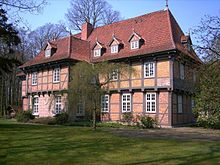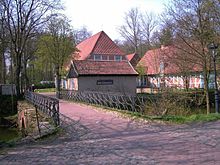Good Sandbeck
Gut Sandbeck , a former knight's seat , is located in the Osterholz district on the Scharmbecker Bach in the district town of Osterholz-Scharmbeck . After extensive restoration, it has served as the city's cultural center since 1981.
history
The Börde Scharmbeck already existed in 768, but is only mentioned in a document as Scirnbeci in 1043 . The names Sandbeck and Scharmbeck are ultimately identical and variations of Scirnbeci ; The original namesake is the Scharmbeck brook , which flows south to the Hamme and closes the Hammebogen.
1182 the name of Westerbeck (Westerbike) was mentioned for the first time; At that time, such names in the documents were often local designations of origin and not always fixed family names.
In 1233 the place Sandbeck was first mentioned by Bertholdus von Westerbike, the ministerial of the Church of St. Petri in Bremen , because he sold his property in Sandbeck for 30 Marks to the monastery in Osterholz .
The monastery passed it on in 1331 and a von Sandbeck family was first mentioned. This place name after the origin of a person (from stand) developed into a permanent part of the name and the letter seal of Heyno von Sandbeck existed since 1343: a clear brook (probably the Scharmbeck brook) on a blue field and an open helmet with three peacock feathers. This seal is mirror-inverted on the signet ring and the crystal clear stream flows from top left to bottom right; in the seal of the documents it appears "correct" from top right to bottom left.
In 1454, Berthold and Heino von Sandbeck entered into an alliance with the city of Bremen, presumably also to get allies in their disputes with the provosts , who, as patrons of the nunnery in Osterholz, monitored the estate's feudal obligations.
This alliance was then demanded and in 1499 Bart (h) old von Sandbeck led 700 men into the battle of Weddewarden (see history of Hadeln and Wursten ), since Archbishop Johann III. Rode von Wale intervened in Wursten , which in turn was in alliance with Count Johann von Oldenburg.
The burden of fiefdom continued to put pressure on von Sandbeck: 1455 and 1500 were the climax of these disagreements, which led to the intervention of the Archbishop of Bremen .
Therefore, in 1513, the monastery in Osterholz was once again enfeoffed with the sand basins in an official act. On a Sunday ( Laetare ) the provost Johann Widdenbrügge therefore invited to the monastery: the mayor of Bremen Marten Heyenbroch, the lords Warner von der Hude and the lords the Cordt brothers appeared as witnesses. The Archbishop of Bremen thus emphasized who exercised secular power in the region; a refusal would have meant the beginning of a feud and the Sandbeckers would probably have lost their fiefdom, which is why Just von Sandbeck (as was customary at the time) tearfully committed himself - in front of his entourage - to the monastery.
Just von Sandbeck died in 1540, but this did not end the conflicts between the two sides for good.
In 1575, today's manor house was built in the - today so called - style of the Weser Renaissance ; However, due to the two crossings of the Scharmbeck brook, the original construction as a moated castle remains visible to this day. The client was Johann von Sandbeck, master builder for the Bremen council carpenter Johan Stollink, who in 1609 also created the upper floor and roof structure of the Bremen town hall .
On April 17, 1552 the Basdahl knighthood carried out a satting ( sate ) in Scharmbeck: 328 horses and 3483 infantry were to provide the region as far as Lesum as military successes in the event of war. Two horses were accounted for on the manor.
The conflict with the monastery escalated in 1613; Herman and Joachim von Sandbeck were charged with breaking into the houses of two Klostermeier with cocked pistols and drawn swords and having caused considerable damage there. One Klostermeier was grossly mistreated, another roughly treated and scolded. The reason for this little laudable behavior was a mockery song composed for the two of them , which the Klostermeier had sung. The reason for the ridicule was the frequent attacks by the two brothers on the Klostermeier.
In 1705 Jürgen Franz von Sandbeck died in office as royal Swedish district administrator. A mill dam was built from heavy stone blocks in 1773 and a water mill was built.
Gottlieb Ernst von Sandbeck was the host from 1789 to 1840; under his direction in 1800 the estate was known as "Edelhof" and had 175 job owners, including a .:
- 46 in Westerbeck
- 20 in Sandbeckerbruch
- 13 in Bargten
During the French period in Bremen from 1812 to 1813, Gottlieb Ernst von Sandbeck was Maire (Mayor) of Mairie Scharmbeck .
In 1855 the last landlord, Friedrich Christian Heinrich August von Sandbeck, died and the formerly large estate - it owned more than 10,000 acres of land - was so heavily indebted that it had to be sold to the banker Carl Hostmann from Celle for 140,000 thalers in the same year . who greatly reduced it through partial sales.
In 1862 it was owned by Mr. Thörnau for 70,000 thalers and in 1875 it was still around 250 acres.
It was bought by the von Hodenberg family in 1886 . In terms of area, the estate was still the largest courtyard in the entire area. Between 1955 and 1975 the property changed hands several times before the city of Osterholz-Scharmbeck acquired the remaining area (including the five existing buildings) from the insurance company IDUNA on September 23, 1975 for DM 380,000 .
During this eventful time, the more or less suitable living space and usage space in the main house, the large barn and the adjacent buildings were rented to companies and private individuals.
The city initially restored (until 1979 only in the lower areas, later completely overarching) only the main building and expanded it into the Gut Sandbeck cultural center . The repair cost a total of 1.6 million DM and was initially completed with the inauguration on June 4, 1981. The original watermill from 1773 was demolished in 1971, but the mill jam still exists. The restoration of the large barn followed in 1984 and the small barn in 1987 ; which have been used culturally since then.
The manor house and the theater barn were the filming location for the TV series Jümmer Justizgeschichten in September 2011 , which was produced by the Hamburg production company miramedia on behalf of the NDR.
Note
- The area (with its sculptures ) can be entered freely.
- The manor is available for weddings; so found there z. B. on July 15, 2006 the marriage of Tim Borowski and Lena Mühlbacher took place.
literature
- Johann Segelken: Osterholz-Scharmbecker Heimatbuch. 4th edition. Saade publishing house, Osterholz-Scharmbeck 1987, ISBN 3-922642-18-7 .
- Copy book of the St. Marien monastery .
- Hannover City Archives, Treasury Register 1534/36.
Web links
- Entry by Frank Both zu Sandbeck in the scientific database " EBIDAT " of the European Castle Institute
Individual evidence
- ↑ Hamme Report: Gut Sandbeck makes it big by Heiko Bosse on August 21, 2011; P. 1.
Coordinates: 53 ° 14 ′ 2 ″ N , 8 ° 46 ′ 52 ″ E



